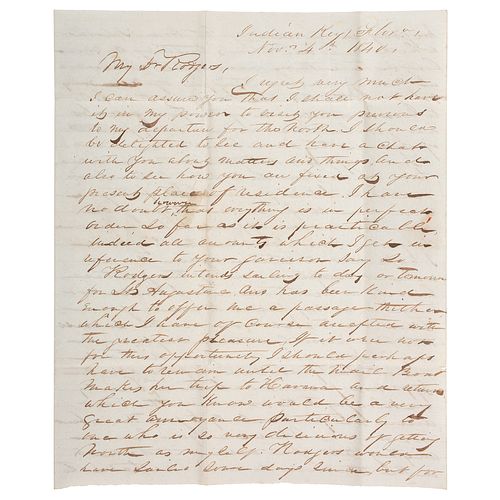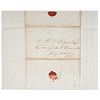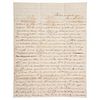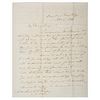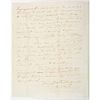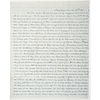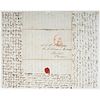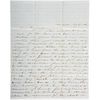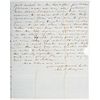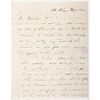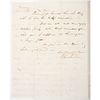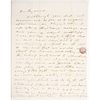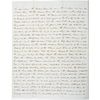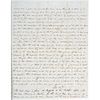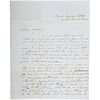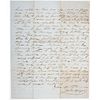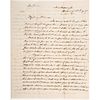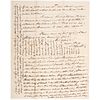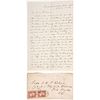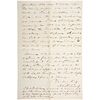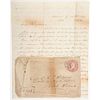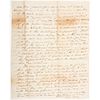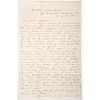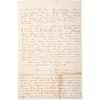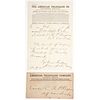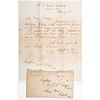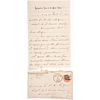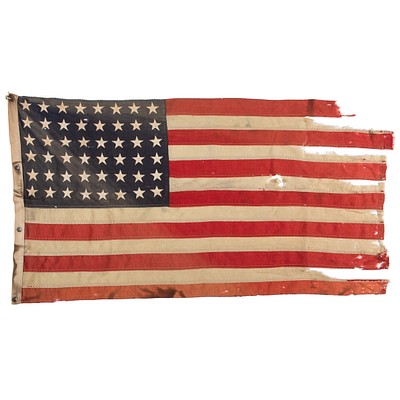USN Archive Featuring Correspondence of Christopher Raymond Perry Rodgers, Incl. Mexican War, Indian War, and Civil War Content
About Seller
6270 Este Ave.
Cincinnati , OH 45232
United States
With offices in Cincinnati, Cleveland and Denver, Cowan’s holds over 40 auctions each year, with annual sales exceeding $16M. We reach buyers around the globe, and take pride in our reputation for integrity, customer service and great results. A full-service house, Cowan’s Auctions specializes in Am...Read more
Two ways to bid:
- Leave a max absentee bid and the platform will bid on your behalf up to your maximum bid during the live auction.
- Bid live during the auction and your bids will be submitted real-time to the auctioneer.
Bid Increments
| Price | Bid Increment |
|---|---|
| $0 | $25 |
| $500 | $50 |
| $1,000 | $100 |
| $2,000 | $250 |
| $5,000 | $500 |
| $10,000 | $1,000 |
| $20,000 | $2,500 |
| $50,000 | $5,000 |
| $100,000 | $10,000 |
About Auction
Jun 26, 2020
Cowan's Auctions is delighted to present the June 26 American Historical Ephemera and Photography Auction, including 55 lots devoted to the African American experience, over 175 lots dating from the Civil War Era, and more than 60 lots documenting life in the American West. Cowan's Auctions dawnie@cowans.com
- Lot Description
USN Archive Featuring Correspondence of Christopher Raymond Perry Rodgers, Incl. Mexican War, Indian War, and Civil War Content
Substantial and historically significant archive of more than 320 letters, most addressed to Rear Admiral Christopher Raymond Perry Rodgers (1819-1892), a career naval officer who hailed from two of the most distinguished families in the history of the US Navy. Correspondence spans 1840s-1890s (bulk 1840s-1860s). Approximately 75 different correspondents with content describing naval activity of the Indian, Mexican-American, and Civil Wars as well as details relative to the private lives of the preeminent Perry and Rodgers families. Correspondents include over a dozen members of the Perry/Rodgers/Slidell families, approximately thirty identified naval officers, and some of the most famous names in nineteenth-century naval history, including Commodore Matthew C. Perry, Rear Admiral John Rodgers, Secretary of the Navy Gideon Welles, Rear Admiral Samuel F. DuPont, Rear Admiral John A. Dahlgren, and Admiral David Dixon Porter.
As the son of Captain George Washington Rodgers (1787-1832) and Anna Maria Perry (1797-1856), nephew to Com. Oliver H. Perry and Com. Matthew C. Perry, and grandson of Capt. Christopher Raymond Perry and Com. John Rodgers, Christopher Raymond Perry "C.R.P." Rodgers was all but destined to follow in the family tradition of service in the United States Navy. He was appointed midshipman on October 5, 1833, then went on to duty with the Pacific, Brazil, Mediterranean, African, and European Squadrons. He commanded the schooner Phoenix during the Seminole War, participated in the siege of Vera Cruz and the capture of Tabasco and Tuxpan by his uncle Com. Matthew C. Perry during the Mexican-American War, and was part of Samuel F. Du Pont's South Atlantic Blockading Squadron during the Civil War. His decades-long career was capped with a two-year tour as Commander of the Pacific Squadron and two separate appointments as Superintendent of the US Naval Academy. Like his uncle Matthew Perry, Rodgers was related by marriage to the influential Slidell family of Louisiana. Rodgers married Julia Slidell (1820-1889) in 1845. Correspondence addressed to her constitutes the bulk of letters in the collection that are not addressed to C.R.P. Rodgers.
The earliest letters in the collection (26 total) span 1840-1842 when Rodgers was stationed at Key West during the Second Seminole War, serving first on board the USS Flirt and later commanding the USS Phoenix. Letters written to Rodgers during this period describe ongoing naval operations in the region and the unfolding issues related to the USN occupation of the remote outpost Indian Key (FL), site of an Indian raid in August 1840. Correspondents include H.D. Taliaferro, Asst. Surgeon on the Flirt, who describes difficulties with the men on Indian Key in a September 1840 letter, noting among other issues the good deal of trouble stirred up after a "grog shop" was opened on the wharf. George H. Terret, future Confederate officer who served as Lieut. of Marines at Indian Key, writes from Indian Key on November 4, 1840, and describes John Rodgers' efforts to find a missing schooner and the departure of Captain Jacob Houseman "one of the greatest rascals in existence." Passed Midshipman H.H. Lewis who served with Rodgers aboard the Flirt writes to Rodgers on January 28 [1841] requesting news since his departure, including discussion of army Col. William S. Harney's controversial attack on Seminole Indians encamped in the Everglades. Additional correspondents include naval officers Francis K. Murray, William Drayton, James S. Ridgely and more.
The Mexican-American War features somewhat less prominently in the archive, however, numerous letters address heightened tensions with Mexico and the evolving military and political situation. Though most recognized for his naval service during the Civil War, Rodgers' younger brother George Washington Rodgers (1832-1863) was a young sailor at the outbreak of the Mexican-American War. Six letters in this collection date to G.W. Rodgers' service aboard the steamer Col. Harvey in New Orleans from October 1845 through May 1846. In addition to describing the company of the Slidells while in New Orleans, G.W. Rodgers writes with news about naval activity in the Gulf and the Pacific. Another letter, dated September 28, 1847, was written while aboard the USS John Adams at Anton Lizardo, and describes the havoc of yellow fever onboard ships, personnel changes, and the military situation in mainland Mexico as he is aware of it. Naval officer (and later Rear Admiral) William Reynolds was a frequent correspondent (16 letters, most 1845-1846). He writes to C.R.P. Rodgers on Dec. 31, 1846, relaying what he knows about the planned attack on Vera Cruz.
The attacks on Charleston Harbor in 1863 under the direction of Samuel F. Du Pont and the activity of the South Atlantic Blockading Squadron constitute a large portion of the Civil War-era content (approx. 35 letters). Additional content of note references the proper outfitting of ironclad ships and the death of George Washington Rodgers during the attack on Ft. Wagner. Naval officers Alexander C. Rhind, William Rodgers Taylor, William Danforth Whiting, John Rodgers, John Henry Upshur, Samuel D. Greene, James Stokes Biddle, Percival Drayton and others are represented. Roughly 20 letters in the collection were written between 1866-1877 by Mrs. Sophie M. Du Pont, wife of Adm. Du Pont, discussing her efforts to restore the name of her husband and other naval matters, with additional correspondence from Mrs. Du Pont extending into the 1880s. Prior to the war, John A. Dahlgren writes to Rodgers regarding ongoing efforts to improve naval technology and gunboats, with a letter of December 15, 1857, describing his work on a version of the "Dahlgren gun."
Outside of a war-time context the letters offer a general perspective on naval operations, in-fighting amongst naval officers, DC-area politics and efforts to modernize the navy, the role of women in supporting their families whilst their husbands are at sea, and the close-knit family relations between the Perry, Slidell, and Rodgers families. Anna Maria Perry Rodgers has approx. 34 letters in the archive, written to her son in the 1840s, and demonstrating a keen awareness of naval matters. Matthew Calbraith Perry has 4 letters in the archive written to C.R.P. Rodgers (3) and his sister Anna Maria Perry Rodgers (1) between 1841-1843 while the commodore was stateside. Mostly content related to family matters, some military discussion, and references to Capt. Alexander Slidell Mackenzie (though not to the Somers mutiny). Two letters dating to the 1870s were written by Gen. William T. Sherman. Approximately 25 letters were written by or addressed to Julia Slidell Rodgers. Additional family correspondents include: Oliver Hazard Perry, Jr., Alexander Perry Rodgers, Raymond Perry Rodgers, Thomas Slidell Rodgers, Elizabeth Rodgers Smith, Fred Rodgers, Alexander Slidell Mackenzie, Frances Slidell, and Mathilde Slidell. Philatelists will note multiple handstamps of interest, including the "Jones' Hotel Philadelphia," the "US Flag Ship Guerriere," and the "US Naval Lyceum," as well as a rare stampless cover identified to "Indian Key." In sum, an archive of exceptional scope, content, and importance, the likes of which is rarely seen outside of institutional holdings.Letters are in good condition and easily legible.Condition
- Shipping Info
-
Buyers are required to pay for all packing, shipping and insurance charges. Overseas duty charges are the responsibility of the successful Bidder. Be aware that for larger and/or valuable items, shipping charges can be substantial. - If there is no shipping amount on listed your invoice, you will need to make arrangements to pick up or ship your purchase through an alternative shipping company. Our shipping department can be contacted at 513.871.1670 (ext. 219) or email shipping@cowans.com. - Shipping charges include insurance for your order while in transit. If you have private insurance we will adjust your charge to include only packing and shipping. - Please allow 14 – 21 days after payment to package and ship your purchase as carefully as possible.
-
- Buyer's Premium



 EUR
EUR CAD
CAD AUD
AUD GBP
GBP MXN
MXN HKD
HKD CNY
CNY MYR
MYR SEK
SEK SGD
SGD CHF
CHF THB
THB